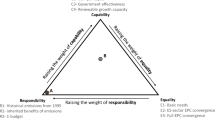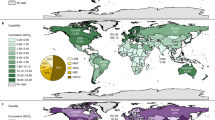Abstract
An important component of the Paris Agreement is the assessment of comparability across nationally determined contributions (NDCs). Indeed, game-theory literature on international environmental agreements highlights the need for comparable emission-mitigation efforts by countries to avoid free-riding1. At the same time, there are well-recognized links between mitigation and other national priorities, including but not limited to the 17 United Nations Sustainable Development Goals (SDGs)2,3,4,5,6, which raises the question of how such links might influence comparability assessments. Here, using a global integrated assessment model7, we demonstrate that geographical distributions of the influence of meeting the domestic mitigation component of the NDCs on a subset of the broader SDGs may not align with distributions of effort across NDCs obtained from conventional emissions-based or cost-based comparability metrics8,9,10,11. This implies that comparability assessments would be altered if interactions between mitigation and other SDGs were accounted for. Furthermore, we demonstrate that the extent to which these distributions differ depends on the degree to which mitigation activities directly affect broader SDGs domestically and indirectly affect international goals, and whether these effects are synergistic or antagonistic. Our analysis provides a foundation for assessing how comparability across NDCs could be better understood in the larger context of sustainability.
This is a preview of subscription content, access via your institution
Access options
Access Nature and 54 other Nature Portfolio journals
Get Nature+, our best-value online-access subscription
$29.99 / 30 days
cancel any time
Subscribe to this journal
Receive 12 print issues and online access
$209.00 per year
only $17.42 per issue
Buy this article
- Purchase on Springer Link
- Instant access to full article PDF
Prices may be subject to local taxes which are calculated during checkout




Similar content being viewed by others
References
Barrett, S. Environment and Statecraft: The Strategy of Environmental Treaty-Making (Oxford Univ. Press, Oxford, 2003).
von Stechow, C. et al. Integrating global climate change mitigation goals with other sustainability objectives: A synthesis. Annu. Rev. Environ. Resour. 40, 363–394 (2015).
von Stechow, C. et al. 2 °C and SDGs: united they stand, divided they fall? Environ. Res. Lett. 11, 034022 (2016).
Griggs, D. et al. Sustainable development goals for people and planet. Nature 495, 305–307 (2013).
Clarke, L. et al. in Climate Change 2014: Mitigation of Climate Change (eds Edenhofer, O. et al.) Ch. 6 (IPCC, Cambridge Univ. Press, Cambridge, 2014).
Sustainable Development Knowledge Platform (United Nations, 2013); https://sustainabledevelopment.un.org/?menu=1300
GCAM v.4.4 Documentation (Joint Global Change Research Institute, accessed 2017); http://jgcri.github.io/gcam-doc/toc.html
Aldy, J. et al. Economic tools to promote transparency and comparability in the Paris Agreement. Nat. Clim. Chang. 6, 1000–1004 (2016).
Gignac, R. & Matthews, H. D. Allocating a 2 °C cumulative carbon budget to countries. Environ. Res. Lett. 10, 075004 (2015).
Aldy, J. E. & Pizer, W. A. Alternative metrics for comparing domestic climate change mitigation efforts and the emerging international climate policy architecture. Rev. Environ. Econ. Policy 10, 3–24 (2016).
Peters, G. P., Andrew, R. M., Solomon, S. & Friedlingstein, P. Measuring a fair and ambitious climate agreement using cumulative emissions. Environ. Res. Lett. 10, 105004 (2015).
Adoption of the Paris Agreement FCCC/CP/2015/L.9/Rev.1 (UNFCCC, 2015); http://unfccc.int/paris_agreement/items/9485.php
Finger, J. M., Reincke, U. & Castro, A. Market access bargaining in the Uruguay Round: rigid or relaxed reciprocity? World Bank Policy Research Working Paper 2258 (World Bank, Washington, 1999).
Ostrom, E. A behavioral approach to the rational choice theory of collective action: presidential address. Am. Polit. Sci. Rev. 92, 1–22 (1998).
Winkler, H. et al. Equitable Access to Sustainable Development: Contribution to the Body of Scientific Knowledge (BASIC expert group, 2011); http://gdrights.org/wp-content/uploads/2011/12/EASD-final.pdf
Fawcett, A. A. et al. Can Paris pledges avert severe climate change? Science 350, 1168–1169 (2015).
INDCs as Communicated by Parties (UNFCCC, 2015); http://www4.unfccc.int/submissions/indc/Submission%20Pages/submissions.aspx
Raupach, M. R. et al. Sharing a quota on cumulative carbon emissions. Nat. Clim. Chang. 4, 873–879 (2014).
den Elzen, M. G. J., Höhne, N., Hagemann, M. M., van Vliet, J. & van Vuuren, D. P. Sharing developed countries’ post-2012 greenhouse gas emission reductions based on comparable efforts. Mitig. Adapt. Strateg. Glob. Chang. 15, 433–465 (2010).
Tavoni, M. et al. The distribution of the major economies’ effort in the Durban platform scenarios. Clim.Change Econ. 4, 1340009 (2013).
du Pont, Y. R., Jeffery, M. L., Gütschow, J., Christoff, P. & Meinshausen, M. National contributions for decarbonizing the world economy in line with the G7 agreement. Environ. Res. Lett. 11, 054005 (2016).
Daioglou, V., van Ruijven, B. J. & van Vuuren, D. P. Model projections for household energy use in developing countries. Energy 37, 601–615 (2012).
Cameron, C. et al. Policy trade-offs between climate mitigation and clean cook-stove access in South Asia. Nat. Energy 1, 15010 (2016).
van Ruijven, B. J. et al. Implications of greenhouse gas emission mitigation scenarios for the main Asian regions. Energy Econ. 34, S459–S469 (2012).
Household Air Pollution and Health (World Health Organization, 2016); http://www.who.int/mediacentre/factsheets/fs292/en/
Rao, S. et al. Better air for better health: Forging synergies in policies for energy access, climate change and air pollution. Glob. Environ. Chang. 23, 1122–1130 (2013).
Jewell, J., Cherp, A. & Riahi, K. Energy security under de-carbonization scenarios: An assessment framework and evaluation under different technology and policy choices. Energy Policy 65, 743–760 (2014).
Persson, T. A., Azar, C., Johansson, D. & Lindgren, K. Major oil exporters may profit rather than lose, in a carbon-constrained world. Energy Policy 35, 6346–6353 (2007).
Calvin, K. et al. Trade-offs of different land and bioenergy policies on the path to achieving climate targets. Clim. Chang. 123, 691–704 (2013).
Wise, M. et al. Implications of limiting CO2 concentrations for land use and energy. Science 324, 1183–1186 (2009).
IPCC Climate Change 2013: The Physical Science Basis (eds T. F. Stocker et al.) 1–30 (Cambridge Univ. Press, Cambridge, 2013).
Rating Countries (Climate Action Tracker, 2016); http://climateactiontracker.org/countries
Iyer, G. et al. Improved representation of investment decisions in assessments of CO2 mitigation. Nat. Clim. Chang. 5, 436–440 (2015).
West, J. J. et al. Co-benefits of global greenhouse gas mitigation for future air quality and human health. Nat. Clim. Chang. 3, 885–889 (2013).
Cherp, A. et al. in Global Energy Assessment — Toward a Sustainable Future 325–384 (Cambridge Univ. Press, Cambridge, 2012).
Jewell, J. et al. Comparison and interactions between the long-term pursuit of energy independence and climate policies. Nat. Energy 1, 16073 (2016).
Introduction to the Basic Concepts of Food Security (Food and Agriculture Organization, 2016); http://www.fao.org/docrep/013/al936e/al936e00.pdf
Hartin, C. A., Bond-Lamberty, B., Patel, P. & Mundra, A. Ocean acidification over the next three centuries using a simple global climate carbon-cycle model: projections and sensitivities. Biogeosciences 13, 4329–4342 (2016).
Calvin, K. et al. Implications of simultaneously mitigating and adapting to climate change: initial experiments using GCAM. Clim. Chang. 117, 545–560 (2012).
Acknowledgements
The research described in this paper was conducted under the Laboratory Directed Research and Development Program at Pacific Northwest National Laboratory, a multiprogramme national laboratory operated by Battelle for the US Department of Energy. The authors are grateful to K. Riahi of the International Institute for Applied Systems Analysis, Austria for his comments on a previous draft of this manuscript.
Author information
Authors and Affiliations
Contributions
G.I., K.C., L.C. and J.E. designed the research. G.I. wrote the first draft of the paper. C.H. conducted ocean health analysis using the Hector model. All authors contributed to writing the paper.
Corresponding author
Ethics declarations
Competing interests
The authors declare no competing financial interests.
Additional information
Publisher’s note: Springer Nature remains neutral with regard to jurisdictional claims in published maps and institutional affiliations.
Supplementary information
Supplementary Information
Supplementary Notes 1–12, Supplementary Figures 1–2, Supplementary Tables 1–4 and Supplementary References.
Compiled Figure 1
Figure 1 presented in a single panel [This Supplementary file initially published was corrupted and has now been replaced.]
Rights and permissions
About this article
Cite this article
Iyer, G., Calvin, K., Clarke, L. et al. Implications of sustainable development considerations for comparability across nationally determined contributions. Nature Clim Change 8, 124–129 (2018). https://doi.org/10.1038/s41558-017-0039-z
Received:
Accepted:
Published:
Issue Date:
DOI: https://doi.org/10.1038/s41558-017-0039-z
This article is cited by
-
Systematic scenario modeling for priority assessment of sustainable development goals in China under interaction and uncertainty
Environment, Development and Sustainability (2024)
-
The impacts of decarbonization pathways on Sustainable Development Goals in the European Union
Communications Earth & Environment (2024)
-
Technology innovations in supply chains: Unlocking Sustainability and SDG Advancement
Environmental Science and Pollution Research (2023)
-
Near-term transition and longer-term physical climate risks of greenhouse gas emissions pathways
Nature Climate Change (2022)
-
Ratcheting of climate pledges needed to limit peak global warming
Nature Climate Change (2022)



